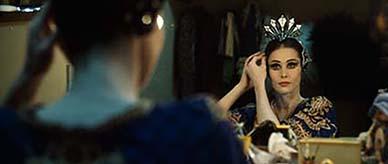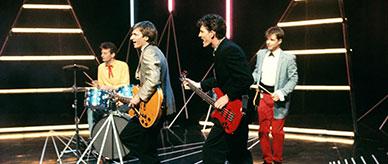
Transcript
Johnny O’Keefe (sings):
Yeah, I’d walk across the burnin’ sands
Just to prove that I’m your lovin’ man
Swing a hammer poundin’ steel on steel
Just to show my love for you is real.
Well don’t you know (yeah, yeah), that my love is real
Well don’t you know (yeah, yeah), my love is strong as steel
Well don’t you know (yeah, yeah), well don’t you know (yeah, yeah)
Well don’t you know (yeah, yeah), well don’t you know (yeah, yeah)
Well don’t you know pretty baby, all my loving belongs-a to you.
I hang around you mornin’, noon and night
To make-a sure that everything’s all right
And when the lonely evenin’ shadows fall
I’ll be around just to hear you call.
Well don’t you know (yeah, yeah), my love is real
Well don’t you know (yeah, yeah), my love is strong as steel
Well don’t you know (yeah, yeah), well don’t you know (yeah, yeah)
Well don’t you know (yeah, yeah) well don’t you know
Don’t you know pretty baby, all my loving belongs-a to you.
Whoa, yeah, yeah, yeah (yeah, yeah, yeah .... )
[INSTRUMENTAL]
Yeah-eah-eah-eah-eah-eah-e-e-es
I’d walk across the burning sands
Just to prove that I’m your lovin’ man
Swing a hammer poundin’ steel on steel
Just to show my love for you is real.
Well don’t you know (yeah, yeah), that my love is real
Well don’t you know (yeah, yeah), my love is strong as steel
Well don’t you know (yeah, yeah), oh don’t you know (yeah, yeah)
Oh don’t you know (yeah, yeah), oh don’t you know (yeah, yeah)
Oh don’t you know pretty baby, all my loving belongs-a to you, yeah, yeah, yeah, yeah.
Don’t you know pretty baby, all my loving belongs-a to you. Yeah, yeah, yeah, yeah.
[APPLAUSE]
Johnny O’Keefe: Thanks very much, the Geoff Clarke Trio, Plus One. Sometime ago we had a first appearance guy on the program by the name of Kevin Todd. We had so many letters that we wanted to have him back again for you. Here he is this time with Andy Rose’s big song hit, The Story of the Rose and the Thorn. Kevin Todd.
Kevin Todd (sings):
Well, a long time ago a little girl loved a boy
And he filled her heart with so much joy
Then one day he left her, didn’t tell her goodbye
Broke the little girl’s heart, made the poor little girl cry
And the rose was born from her tears that fell
All heaven cried with her that’s the story they tell
When you see a rainbow after the storm
You know a love has died, a little girl’s cried and a rose was born.
Well the time moves along, the little boy met a girl
She captured his heart and set him in a whirl
Then one day she left him, didn’t tell him goodbye
Broke the little boy’s heart and made the poor little boy cry
But a thorn was born from the tears that he shed
And down through the ages to the roses beware
It’s just a reminder, a sign meant to warn
A little boy lied, a little boy cried and a thorn was born
That’s the story of a rose and the thorn
That’s the story of the rose and the thorn
That’s the story of the rose and the thorn
That’s the story of the rose and the thorn.
[APPLAUSE]
[END]
About this record
This black-and-white audio-visual clip is from the live-music television program Six O’Clock Rock. It features a performance of the song ‘Don’t You Know’ by compere and singer Johnny O’Keefe (rated number one in the charts at the time) and a performance of ‘The Story of the Rose and the Thorn’ by singer Kevin Todd. During these performances, the resident band and dancers are shown on stage and the footage includes shots of members of the live studio audience—some of whom wave to the camera and sing along.
Educational value
- Through its charter, the ABC develops and supports Australian content, and over the years it has achieved great success with music programs, including television shows such as Countdown and Rage and Triple J radio.
- Through its programming of the groundbreaking television program Six O’Clock Rock, the Australian Broadcasting Commission (ABC) played a pioneering role in nurturing the local music industry in Australia. The show promoted local musical talent and regularly showcased new artists such as Kevin Todd (shown in this clip).
- This clip is a sample of Six O’Clock Rock. The show’s format was based on the British Broadcasting Corporation’s Six-Five Special. As with Channel 9’s Bandstand, Six O’Clock Rock took advantage of the novelty of television to bring rock ‘n’ roll into people’s lounge rooms. It quickly cemented television’s place in Australian popular culture.
- Johnny O’Keefe, shown in this clip, was a pioneer of rock'n'roll music in Australia. After his breakthrough hit ‘Wild One’ in 1958, O’Keefe became a widely popular entertainer in Australia. He toured the United States of America and had a string of top ten hits including ‘Shout’, ‘She’s My Baby’ and ‘She Wears My Ring’. After hosting Six O’Clock Rock for two years, O’Keefe moved to Channel 7 to anchor The Johnny O’Keefe Show.
- The style and format of the television program included here is indicative of music shows of the time. Television was still in its infancy in Australia and new program formats were being adapted from overseas counterparts. In both music performances shown, the dancers provide a moving backdrop to the featured artist, who sings on stage while the audience is seated quietly in the studio. Different camera angles capture close ups of each element of the performance.
- The age range of the studio audience would be unusual in a popular music program today, but probably indicates the wide appeal of the still-new medium of television. Although Six O’Clock Rock was seen to appeal to a younger teenage market—O’Keefe was known as ‘The Wild One’—the studio audience includes families, young couples, older people and teenagers. Its commercial counterpart, Bandstand, also appealed to families.
Acknowledgments
Reproduced with the permission of the Australian Broadcasting Corporation – Library Sales.
Related themes
Need help with your research?
Learn how to interpret primary sources, use our collection and more.


